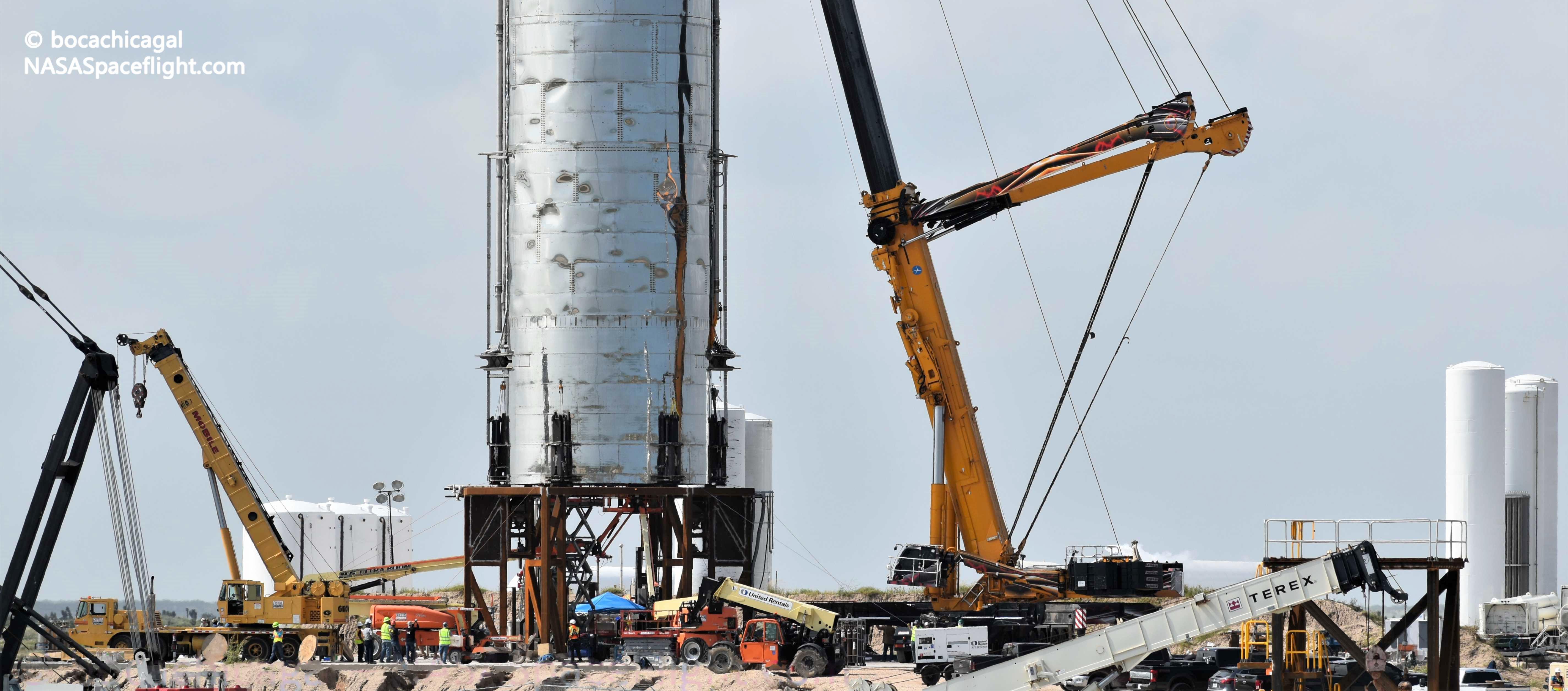

News
SpaceX’s Starship Mk1 prototype heads to the launch pad – but why?
SpaceX has transported (half of) its Starship Mk1 prototype to its South Texas launch pad for the first time ever, signifying that the company is about to enter a major new stage of testing.
The move, however, raises the question: why is SpaceX transporting only half of Starship Mk1 to the launch pad?
Following SpaceX CEO Elon Musk’s September 28th presentation on Starship, the spacecraft prototype was partially disassembled, having essentially been mocked up to stand as a backdrop at the event. The impact was fairly minor, taking up no more than a few days of work, but Starship Mk1 remains in two large, separate pieces – a curved nose section and the ship’s cylindrical propellant tank and propulsion section.
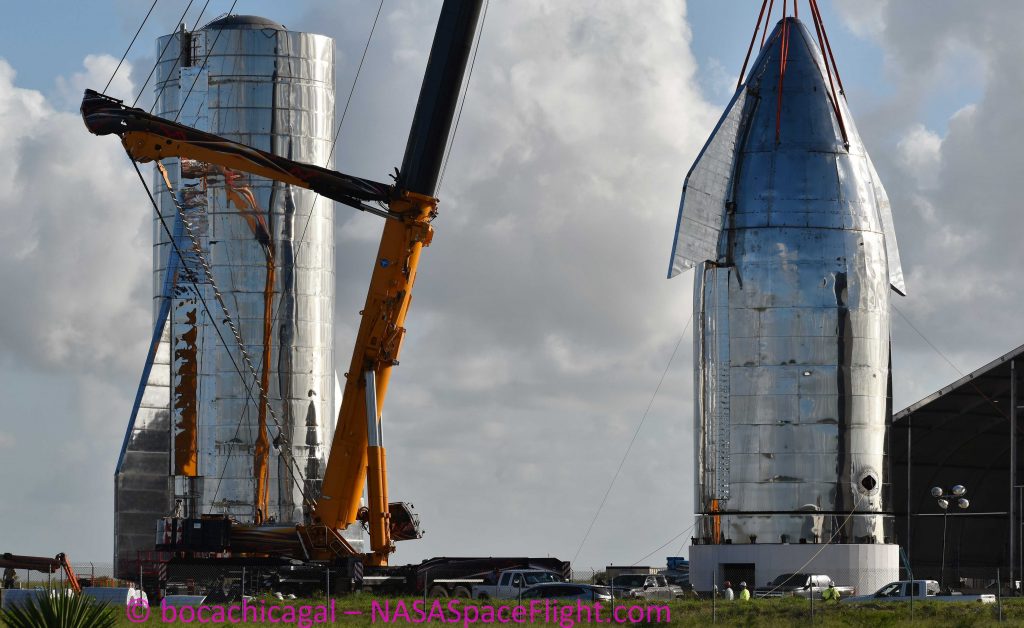
A little over a month after Musk’s presentation, SpaceX technicians freed Starship Mk1’s lower tank section from a steel mount and temporarily installed the giant half-spacecraft on framework mounted to a Roll Lift transporter. SpaceX has consistently relied on Roll Lifts for the task of transporting Starship’s massive segments both around and between its Boca Chica, Texas build and launch facilities. This time around, only Starship Mk1’s lower half was loaded onto the transporter before being staged overnight near the main gate of SpaceX’s build site.
Although work continued throughout the night, around dawn on October 30th, transport activity restarted in earnest, with technicians preparing to move Starship. A road closure filed with Cameron County suggested that something would occur on the 30th, with followers speculating that Starship Mk1 would be transported to SpaceX’s South Texas launch pad. As it turned out, that speculation was correct, and (half of) Starship Mk1 was indeed moved to the launch pad and installed atop a new launch mount that was built from scratch in just a few months.
(Half a) Starship on the pad
While it’s undeniably thrilling to see Starship Mk1 head to SpaceX’s Boca Chica launch pad for the first time ever, it remains to be seen why exactly only half of the rocket was transported – no mean feat. Although a great deal of progress has been made over the last month outfitting Starship Mk1 with all the wiring, electronics, plumbing, and other subsystems the prototype will need to function, it’s plainly visible that a significant amount of work remains before Starship will be ready for integrated testing.
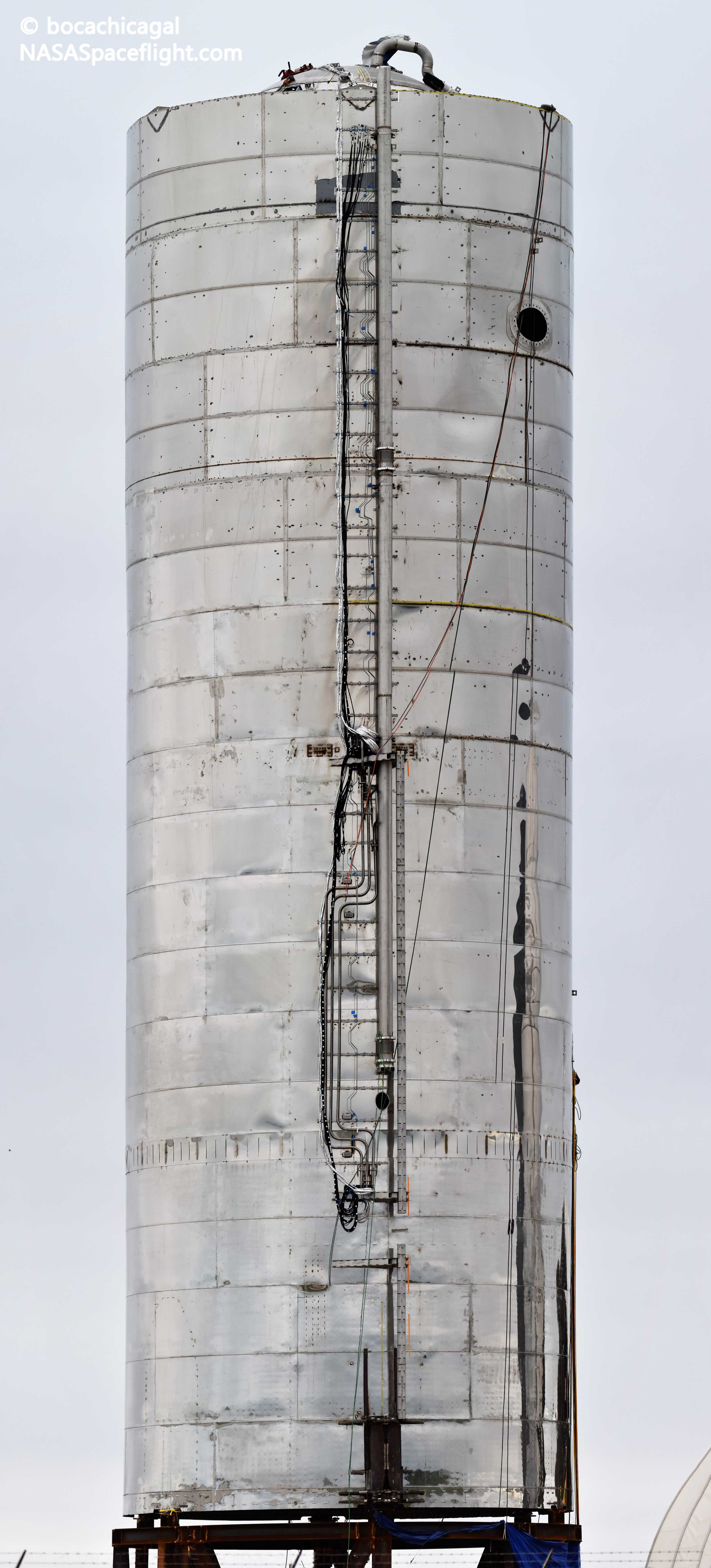
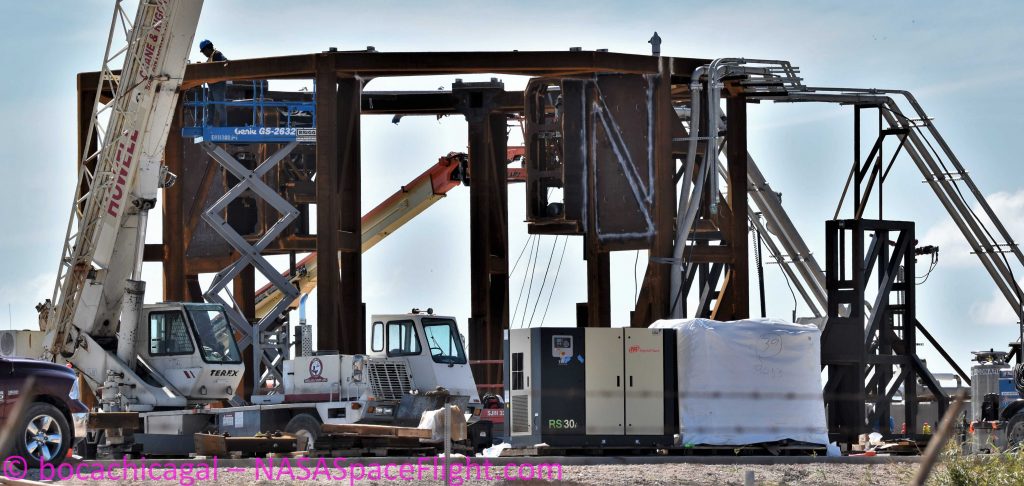
Most notably, as pictured above, the launch mount frame is certainly more or less complete, but most of the complex plumbing, wiring, and power equipment it will need to serve its function is not obviously present. There is admittedly a possibility that SpaceX will reuse the ‘quick disconnect’ umbilical ports used by Starhopper on Starship Mk1, but that remains to be seen.
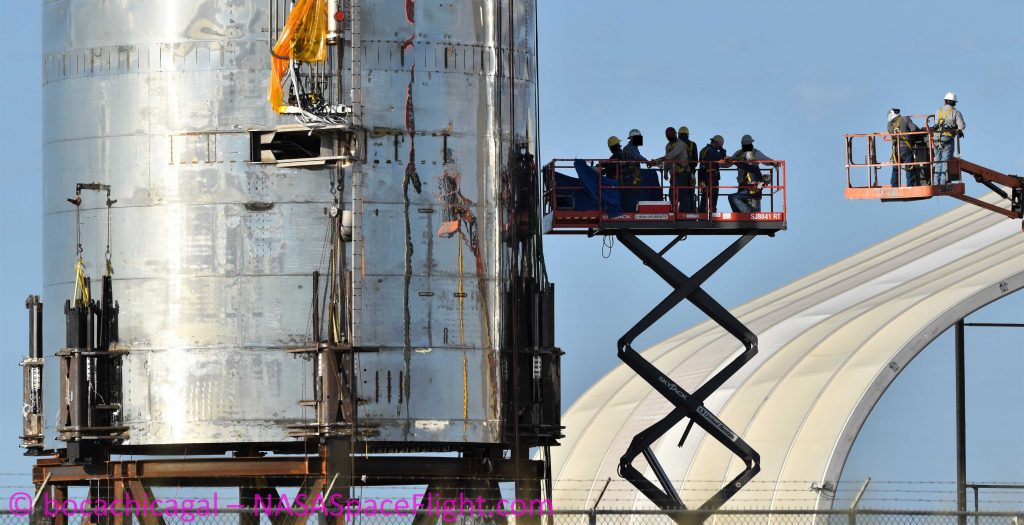
Additionally, Starship Mk1 also has some level of work left before it will be ready for its first propellant loading test, let alone flight. Aside from a large amount of wiring and avionics that still needs to be partially run, harnessed, and connected, Starship’s main liquid oxygen and methane feedlines – needed to fuel the rocket – are largely complete but still unfinished.
There are at least a few obvious possible explanations for SpaceX moving the Starship Mk1 tank section to the launch pad in its partially-finished state. The easiest explanation is that SpaceX wants to perform leak and pressure tests of Starship’s tanks as early as possible, even if that involves testing the rocket without its nose (the host of Mk1’s batteries, power controllers, COPVs, pressurization tanks, and more). It’s not clear that Starship Mk1 is – at present – capable of performing a wet dress rehearsal (WDR), a common aerospace test where a rocket is fully fueled and counts down to launch without actually igniting.

Instead, SpaceX could potentially perform a pressure (or at least leak) test with a neutral gas (or perhaps liquid nitrogen) just to verify that Starship Mk1 is structurally sound before kicking off cryogenic propellant loading. Additionally, it’s possible that SpaceX could get around Mk1’s incomplete propellant feed lines by attaching pad umbilicals directly to the ends of the incomplete feed lines.
At the same time, it’s possible that SpaceX has decided to finish assembling Starship at the launch pad itself, hinted at when a local photographer captured a number of Mk1’s control surfaces and aero covers being moved around shortly after Starship was moved to the pad. Time will tell. For the time being, SpaceX has no more road closures scheduled (meaning no nose section transport) until November 7th and 8th, followed by another on the 12th.
Stay tuned to find out what transpires!
Check out Teslarati’s Marketplace! We offer Tesla accessories, including for the Tesla Cybertruck and Tesla Model 3.
News
Tesla UK sales see 14% year-over-year rebound in June: SMMT data
The SMMT stated that Tesla sales grew 14% year-over-year to 7,719 units in June 2025.

Tesla’s sales in the United Kingdom rose in June, climbing 14% year-over-year to 7,719 units, as per data from the Society of Motor Manufacturers and Traders (SMMT). The spike in the company’s sales coincided with the first deliveries of the updated Model Y last month.
Model Y deliveries support Tesla’s UK recovery
Tesla’s June performance marked one of its strongest months in the UK so far this year, with new Model Y deliveries contributing significantly to the company’s momentum.
While the SMMT listed Tesla with 7,719 deliveries in June, independent data from New AutoMotive suggested that the electric vehicle maker registered 7,891 units during the month instead. However, year-to-date figures for Tesla remain 2% down compared to 2024, as per a report from Reuters.
While Tesla made a strong showing in June, rivals are also growing. Chinese automaker BYD saw UK sales rise nearly fourfold to 2,498 units, while Ford posted the highest EV growth among major automakers, with a more than fourfold increase in the first half of 2025.
Overall, the UK’s battery electric vehicle (BEV) demand surged 39% to to 47,354 units last month, helping push total new car sales in the UK to 191,316 units, up 6.7% from the same period in 2024.
EV adoption accelerates, but concerns linger
June marked the best month for UK car sales since 2019, though the SMMT cautioned that growth in the electric vehicle sector remains heavily dependent on discounting and support programs. Still, one in four new vehicle buyers in June chose a battery electric vehicle.
SMMT Chief Executive Mike Hawes noted that despite strong BEV demand, sales levels are still below regulatory targets. “Further growth in sales, and the sector will rely on increased and improved charging facilities to boost mainstream electric vehicle adoption,” Hawes stated.
Also taking effect this week was a new US-UK trade deal, which lowers tariffs on UK car exports to the United States from 27.5% to 10%. The agreement could benefit UK-based EV producers aiming to expand across the country.
News
Tesla Model 3 ranks as the safest new car in Europe for 2025, per Euro NCAP tests
Despite being on the market longer than many of its rivals, the Tesla Model 3 continues to set the bar for vehicle safety.

The Tesla Model 3 has been named the safest new car on sale in 2025, according to the latest results from the Euro NCAP. Among 20 newly tested vehicles, the Model 3 emerged at the top of the list, scoring an impressive 359 out of 400 possible points across all major safety categories.
Tesla Model 3’s safety systems
Despite being on the market longer than many of its rivals, the Tesla Model 3 continues to set the bar for vehicle safety. Under Euro NCAP’s stricter 2025 testing protocols, the electric sedan earned 90% for adult occupant protection, 93% for child occupant protection, 89% for pedestrian protection, and 87% for its Safety Assist systems.
The updated Model 3 received particular praise for its advanced driver assistance features, including Tesla’s autonomous emergency braking (AEB) system, which performed well across various test scenarios. Its Intelligent Speed Assistance and child presence detection system were cited as noteworthy features as well, as per a WhatCar report.
Other notable safety features include the Model 3’s pedestrian-friendly pop-up hood and robust crash protection for both front and side collisions. Euro NCAP also highlighted the Model 3’s ability to detect vulnerable road users during complex maneuvers, such as turning across oncoming traffic.
Euro NCAP’s Autopilot caution
While the Model 3’s safety scores were impressive across the board, Euro NCAP did raise concerns about driver expectations of Tesla’s Autopilot system. The organization warned that some owners may overestimate the system’s capabilities, potentially leading to misuse or inattention behind the wheel. Even so, the Model 3 remained the highest-scoring vehicle tested under Euro NCAP’s updated criteria this year.
The Euro NCAP’s concerns are also quite interesting because Tesla’s Full Self-Driving (FSD) Supervised, which is arguably the company’s most robust safety suite, is not allowed for public rollout in Europe yet. FSD Supervised would allow the Model 3 to navigate inner city streets with only minimal human supervision.
Other top scorers included the Volkswagen ID.7, Polestar 3, and Geely EX5, but none matched the Model 3’s total score or consistency across categories. A total of 14 out of 20 newly tested cars earned five stars, while several models, including the Kia EV3, MG ZS, and Renault 5, fell short of the top rating.
Elon Musk
Why Tesla’s Q3 could be one of its biggest quarters in history
Tesla could stand to benefit from the removal of the $7,500 EV tax credit at the end of Q3.

Tesla has gotten off to a slow start in 2025, as the first half of the year has not been one to remember from a delivery perspective.
However, Q3 could end up being one of the best the company has had in history, with the United States potentially being a major contributor to what might reverse a slow start to the year.
Earlier today, the United States’ House of Representatives officially passed President Trump’s “Big Beautiful Bill,” after it made its way through the Senate earlier this week. The bill will head to President Trump, as he looks to sign it before his July 4 deadline.
The Bill will effectively bring closure to the $7,500 EV tax credit, which will end on September 30, 2025. This means, over the next three months in the United States, those who are looking to buy an EV will have their last chance to take advantage of the credit. EVs will then be, for most people, $7,500 more expensive, in essence.
The tax credit is available to any single filer who makes under $150,000 per year, $225,000 a year to a head of household, and $300,000 to couples filing jointly.
Ending the tax credit was expected with the Trump administration, as his policies have leaned significantly toward reliance on fossil fuels, ending what he calls an “EV mandate.” He has used this phrase several times in disagreements with Tesla CEO Elon Musk.
Nevertheless, those who have been on the fence about buying a Tesla, or any EV, for that matter, will have some decisions to make in the next three months. While all companies will stand to benefit from this time crunch, Tesla could be the true winner because of its sheer volume.
If things are done correctly, meaning if Tesla can also offer incentives like 0% APR, special pricing on leasing or financing, or other advantages (like free Red, White, and Blue for a short period of time in celebration of Independence Day), it could see some real volume in sales this quarter.
You can now buy a Tesla in Red, White, and Blue for free until July 14 https://t.co/iAwhaRFOH0
— TESLARATI (@Teslarati) July 3, 2025
Tesla is just a shade under 721,000 deliveries for the year, so it’s on pace for roughly 1.4 million for 2025. This would be a decrease from the 1.8 million cars it delivered in each of the last two years. Traditionally, the second half of the year has produced Tesla’s strongest quarters. Its top three quarters in terms of deliveries are Q4 2024 with 495,570 vehicles, Q4 2023 with 484,507 vehicles, and Q3 2024 with 462,890 vehicles.
-

 Elon Musk4 days ago
Elon Musk4 days agoTesla investors will be shocked by Jim Cramer’s latest assessment
-

 News1 week ago
News1 week agoTesla Robotaxi’s biggest challenge seems to be this one thing
-

 Elon Musk2 weeks ago
Elon Musk2 weeks agoFirst Look at Tesla’s Robotaxi App: features, design, and more
-

 News2 weeks ago
News2 weeks agoSpaceX and Elon Musk share insights on Starship Ship 36’s RUD
-

 News2 weeks ago
News2 weeks agoWatch Tesla’s first driverless public Robotaxi rides in Texas
-

 News1 week ago
News1 week agoWatch the first true Tesla Robotaxi intervention by safety monitor
-

 News2 weeks ago
News2 weeks agoTesla has started rolling out initial round of Robotaxi invites
-

 Elon Musk2 weeks ago
Elon Musk2 weeks agoTesla to launch in India in July with vehicles already arriving: report


















